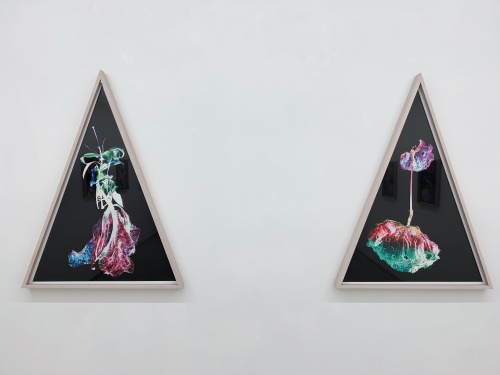WITHERED FLOWERS REVERSE
GALLERY HOURS | Thu.–Sat. 11:00–13:00, 14:00–19:00
CLOSED | Sun–Wed., National Holidays
*Summer Holidays | August 10 – August 12, 2023
*Depending on COVID-19, the exhibition period and the content may be changed.
The material these works here were made from, was taken from two series of photos of flowers – color and black-and-white – that I made in the past. Different from collages, where miscellaneous things are mixed together in one single work, these are collages that exclusively contain my own previous flower photographs. I started with items from the black-and-white series, which caused in me a strong urge to join the single flowers together. There are no rules for collages, and I wasn’t satisfied by just scattering the flowers around. After all, this is perhaps the way I work in general. At some point in the process, I reverted the color photographs into negative images, and found the resulting color combinations and overall impressions intriguingly refreshing. They reminded me of the films of Kenneth Anger, or 1980s New York underground artists such as Herve Di Rosa, and renewed my awareness that this particular color sensation, which affected my work most profoundly, was still alive inside me. The final result was a trilogy of color, black-and-white and negative (reverse) images of flowers. Different from previous photographs finished with my usual tones, for these series I took an approach that was completely free and without limitations, which turned out to be a joyful and at once also painful operation. At the early stage of the creative process, I feared that I might reach a dead end somewhere along the way, but the more I worked on it, my brain seemed to gradually move into some kind of “zone,” and from there I thoroughly enjoyed the ride. When I look at the results, in some way I feel my own personal character oozing out from them more explicitly compared to straight photography. I dedicate these images to Ryuichi Sakamoto, my life teacher who introduced me to the world of art.
– by Tajima Kazunali (a part)
Artist
Kazunali TAJIMA
田島 一成
Kazunali Tajima, born in 1968 in Tokyo.
After working as an assistant for photographer Akira Gomi, from 1989.
Start working as a photographer in Paris and New York. Active in Tokyo since 2002.
As a advertisement, fashion photographer. His works also seen in the fields of music videos and TV commercials.
1997 American Photographie Annual. 2007, 2013 TOKYO ADC AWARD.
Publication

WITHERED FLOWERS REVERSE
The material these works here were made from, was taken from two series of photos of flowers – color and black-and-white – that I made in the past. Different from collages, where miscellaneous things are mixed together in one single work, these are collages that exclusively contain my own previous flower photographs. I started with items from the black-and-white series, which caused in me a strong urge to join the single flowers together. There are no rules for collages, and I wasn’t satisfied by just scattering the flowers around. After all, this is perhaps the way I work in general. At some point in the process, I reverted the color photographs into negative images, and found the resulting color combinations and overall impressions intriguingly refreshing. They reminded me of the films of Kenneth Anger, or 1980s New York underground artists such as Herve Di Rosa, and renewed my awareness that this particular color sensation, which affected my work most profoundly, was still alive inside me. The final result was a trilogy of color, black-and-white and negative (reverse) images of flowers. Different from previous photographs finished with my usual tones, for these series I took an approach that was completely free and without limitations, which turned out to be a joyful and at once also painful operation. At the early stage of the creative process, I feared that I might reach a dead end somewhere along the way, but the more I worked on it, my brain seemed to gradually move into some kind of “zone,” and from there I thoroughly enjoyed the ride. When I look at the results, in some way I feel my own personal character oozing out from them more explicitly compared to straight photography. I dedicate these images to Ryuichi Sakamoto, my life teacher who introduced me to the world of art.
– After words by Tajima Kazunali (a part)

WITHERED FLOWERS
I like withered flowers. However I do feel that flowers are actually dead as soon as they are cut off from the stem, or taken out of the soil they grew from. So even the prettiest flower arrangement, after all, consists of dead flowers that are already on the road to decay. Speaking of decay, this naturally reminds me of the fact that decay is what we humans are bound for as well. When applying the image of the flower to myself as someone who has already begun to wither, I could probably say that I am now disconnected from my soil, too.
This Tajjiemax (Tajima Kazunali) photo book made me realize for the first time that fashion photography is an art form in its own right, that exists independently from the art of photography at large. It also showed me that this is one photographer who seems to be taking pride in devoting himself to fashion photography.
Withered flowers are beautiful. But why is it that they look so beautiful to us? This has to be related to the fact that we sense in them some kind of mutability. Flowers demonstrate in a beautiful way the factual reality of life and death. Why are flowers beautiful in the first place? According to a certain scientist, it is because they want to entertain insects and humans with their prettiness. I believe that is true.
– from the Afterword by Ryuichi Sakamoto
These may be different from what people usually consider as “beautiful flower photographs,” but they are pictures that were taken to honestly reflect my feelings, without incorporating anyone else’s views and perceptions.
– from the artist's statement by Kazunali Tajima

WITHERED FLOWERS (Special Edition) A
Akio Nagasawa Publishing is excited to release the special edition of WITHERED FLOWERS.
One original print included signed on verso. The original print can be chosen from theree different images. Limited edition of 20 copies for each image.
I like withered flowers. However I do feel that flowers are actually dead as soon as they are cut off from the stem, or taken out of the soil they grew from. So even the prettiest flower arrangement, after all, consists of dead flowers that are already on the road to decay. Speaking of decay, this naturally reminds me of the fact that decay is what we humans are bound for as well. When applying the image of the flower to myself as someone who has already begun to wither, I could probably say that I am now disconnected from my soil, too.
This Tajjiemax (Tajima Kazunali) photo book made me realize for the first time that fashion photography is an art form in its own right, that exists independently from the art of photography at large. It also showed me that this is one photographer who seems to be taking pride in devoting himself to fashion photography.
Withered flowers are beautiful. But why is it that they look so beautiful to us? This has to be related to the fact that we sense in them some kind of mutability. Flowers demonstrate in a beautiful way the factual reality of life and death. Why are flowers beautiful in the first place? According to a certain scientist, it is because they want to entertain insects and humans with their prettiness. I believe that is true.
– from the Afterword by Ryuichi Sakamoto
These may be different from what people usually consider as “beautiful flower photographs,” but they are pictures that were taken to honestly reflect my feelings, without incorporating anyone else’s views and perceptions.
– from the artist's statement by Kazunali Tajima

WITHERED FLOWERS (Special Edition) B
Akio Nagasawa Publishing is excited to release the special edition of WITHERED FLOWERS.
One original print included signed on verso. The original print can be chosen from theree different images. Limited edition of 20 copies for each image.
I like withered flowers. However I do feel that flowers are actually dead as soon as they are cut off from the stem, or taken out of the soil they grew from. So even the prettiest flower arrangement, after all, consists of dead flowers that are already on the road to decay. Speaking of decay, this naturally reminds me of the fact that decay is what we humans are bound for as well. When applying the image of the flower to myself as someone who has already begun to wither, I could probably say that I am now disconnected from my soil, too.
This Tajjiemax (Tajima Kazunali) photo book made me realize for the first time that fashion photography is an art form in its own right, that exists independently from the art of photography at large. It also showed me that this is one photographer who seems to be taking pride in devoting himself to fashion photography.
Withered flowers are beautiful. But why is it that they look so beautiful to us? This has to be related to the fact that we sense in them some kind of mutability. Flowers demonstrate in a beautiful way the factual reality of life and death. Why are flowers beautiful in the first place? According to a certain scientist, it is because they want to entertain insects and humans with their prettiness. I believe that is true.
– from the Afterword by Ryuichi Sakamoto
These may be different from what people usually consider as “beautiful flower photographs,” but they are pictures that were taken to honestly reflect my feelings, without incorporating anyone else’s views and perceptions.
– from the artist's statement by Kazunali Tajima

WITHERED FLOWERS (Special Edition) C
Akio Nagasawa Publishing is excited to release the special edition of WITHERED FLOWERS.
One original print included signed on verso. The original print can be chosen from theree different images. Limited edition of 20 copies for each image.
I like withered flowers. However I do feel that flowers are actually dead as soon as they are cut off from the stem, or taken out of the soil they grew from. So even the prettiest flower arrangement, after all, consists of dead flowers that are already on the road to decay. Speaking of decay, this naturally reminds me of the fact that decay is what we humans are bound for as well. When applying the image of the flower to myself as someone who has already begun to wither, I could probably say that I am now disconnected from my soil, too.
This Tajjiemax (Tajima Kazunali) photo book made me realize for the first time that fashion photography is an art form in its own right, that exists independently from the art of photography at large. It also showed me that this is one photographer who seems to be taking pride in devoting himself to fashion photography.
Withered flowers are beautiful. But why is it that they look so beautiful to us? This has to be related to the fact that we sense in them some kind of mutability. Flowers demonstrate in a beautiful way the factual reality of life and death. Why are flowers beautiful in the first place? According to a certain scientist, it is because they want to entertain insects and humans with their prettiness. I believe that is true.
– from the Afterword by Ryuichi Sakamoto
These may be different from what people usually consider as “beautiful flower photographs,” but they are pictures that were taken to honestly reflect my feelings, without incorporating anyone else’s views and perceptions.
– from the artist's statement by Kazunali Tajima

WITHERED FLOWERS BLACK
Black-and-white photographs are something special. The history of photography started black and white, even though our eyes perceive the world in color, and they do not see things in monochrome. It’s a unique world altogether. If the first photographic film had been a color film, there would probably exist no black-and-white images at all today. Nonetheless, there is some kind of magic that keeps attracting us photographers to the simplicity, the modernism, the sharpness of photos shot in black-and-white. I have spent the past seven years waiting for flowers to decay and shoot photographs to express in my own way the atmosphere of withered flowers, with all the minute details, the beautiful moods and textures of what looks like wrinkled skin. Why is it that people are entranced by flowers? Were all the beautiful designs and colorations of flowers only made to captivate us humans? (...) In order to make the monochromatic images in this series look more appealing than the color ones, I worked out quite elaborate lighting settings for the shootings. Compared to the color pictures, the results may appear more “photographic,” which means that here it is perhaps the “photograph” itself that is presented, rather than the “flower” in it.
– Afterword by Kazunali Tajima (a part)
































